六年级英语上册第六单元知识点归纳及复习题(人教版)
最新完整版人教版六年级英语上册总复习各单元知识点归纳总结及作文范文汇总
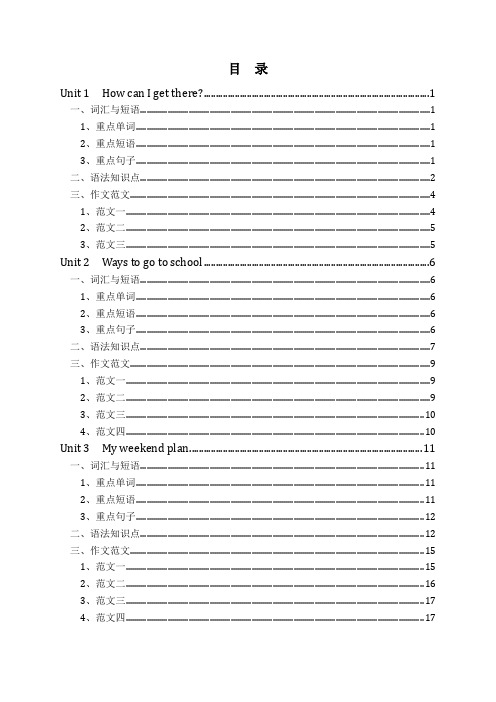
目录Unit 1 How can I get there? (1)一、词汇与短语 (1)1、重点单词 (1)2、重点短语 (1)3、重点句子 (1)二、语法知识点 (2)三、作文范文 (4)1、范文一 (4)2、范文二 (5)3、范文三 (5)Unit 2 Ways to go to school (6)一、词汇与短语 (6)1、重点单词 (6)2、重点短语 (6)3、重点句子 (6)二、语法知识点 (7)三、作文范文 (9)1、范文一 (9)2、范文二 (9)3、范文三 (10)4、范文四 (10)Unit 3 My weekend plan (11)一、词汇与短语 (11)1、重点单词 (11)2、重点短语 (11)3、重点句子 (12)二、语法知识点 (12)三、作文范文 (15)1、范文一 (15)2、范文二 (16)3、范文三 (17)4、范文四 (17)Unit 4 I have a pen pal (18)一、词汇与短语 (18)1、重点单词 (18)2、重点短语 (18)3、重点句子 (18)二、语法知识点 (19)三、作文范文 (23)1、范文一 (24)2、范文二 (24)3、范文三 (25)4、范文四 (25)Unit 5 What does he do (27)一、词汇与短语 (27)1、重点单词 (27)2、重点短语 (27)3、重点句子 (27)二、语法知识点 (28)三、作文范文 (30)1、范文一 (30)2、范文二 (31)3、范文三 (31)Unit 6 How do you feel (32)一、词汇与短语 (32)1、重点单词 (32)2、重点短语 (32)3、重点句子 (32)二、语法知识点 (33)三、作文范文 (34)1、范文一 (35)2、范文二 (35)3、范文三 (35)4、范文四 (35)语法知识点 (37)肯定句如何变否定句 (37)肯定句如何变一般疑问句 (39)划线部分提问(如何变特殊疑问句) (41)写作训练 (43)写作训练答案 (47)Unit 1 How can I get there?一、词汇与短语1、重点单词1.science /ˈsaɪəns/ 科学2.museum /mjuˈziːəm/ 博物馆3.post office /ˈpəʊst ɒfɪs/ 邮局4.bookstore /ˈbʊkstɔː/ 书店5.cinema /ˈsɪnəmə/ 电影院6.hospital /ˈhɒspɪtl/ 医院7.crossing /ˈkrɒsɪŋ/ 十字路口8.turn /tɜːn/ 转湾9.left /left/ 左10.right /raɪt/ 右11.straight /streɪt/ 笔直地12.ask /ɑːsk/ 问13.sir /sɜː(r)/ (对男子的礼貌称呼)先生14.interesting /ˈɪntrəstɪŋ/ 有趣的15.Italian /ɪˈtæliən/ 意大利的16.restaurant /ˈrestrɒnt/ 餐馆17.pizza /ˈpiːtsə/ 比萨饼18.street /striːt]/ 大街;街道19.get /get/ 到达20.gave /ɡeɪv/( give/ɡɪv/的过去式) 给21.follow /ˈfɒləʊ/ 跟着22.tell /tel/ 告诉2、重点短语1.science museum 科学博物馆2.near the library 图书馆附近3.get there 到达那里4.go straight 直走5.turn left/right 向左转/右转6.over there 在那边7.next to the museum 在博物馆旁边8.pet hospital 宠物医院9.Palace museum 故宫博物院10.in front of 在…前面11.behind the post office 在邮局后面12.beside the park 在公园旁边13.be far from 离……很远14.be far from home 远离家乡3、重点句子1. --Where is the museum shop?博物馆商店在哪里--It's near the door. 它在门附近。
六年级上册英语u6知识点

六年级上册英语u6知识点以下是六年级上册英语U6的知识点总结:一、词汇本单元涉及的词汇主要包括学校设施、课程和活动相关的单词,例如:•gym 体育馆•art room 美术室•music room 音乐室•computer room 电脑室•library 图书馆•playground 操场•science lab 科学实验室•PE class 体育课•music class 音乐课•art class 美术课•computer class 电脑课二、句型1.询问某人在哪里:Where is ...? / Where are ...? 例如:Where is the gym? 体育馆在哪里?2.询问某人是否喜欢某物或做某事:Do you like ...? 例如:Do you like PE class? 你喜欢体育课吗?3.询问某人是否在某个地方:Is ... in/on/under ...? 例如:Is the ball in the gym? 球在体育馆里吗?4.表达喜欢做某事:I like ... 例如:I like playingbasketball. 我喜欢打篮球。
5.表达某人在某处做某事:... is/are ...ingin/on/under ... 例如:They are playing football on the playground. 他们在操场上踢足球。
三、语法1.现在进行时的用法:表示正在进行的动作或状态,通常由“be动词(am/is/are)+动词-ing”构成。
例如:They areplaying football. 他们正在踢足球。
2.一般现在时的用法:表示经常或习惯性的动作或状态,以及客观事实或普遍真理。
例如:I like playing basketball. 我喜欢打篮球。
3.特殊疑问句的用法:以特殊疑问词(如where、what、who等)开头的疑问句,用于询问特定的信息。
六年级上册英语单元基础知识梳理默写+单元重难点突破+综合能力提升练-Unit 6 Keep our
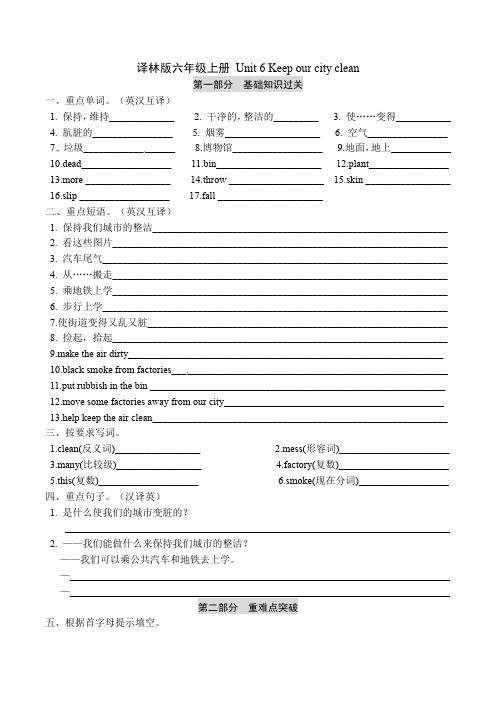
译林版六年级上册Unit 6 Keep our city clean第一部分基础知识过关一、重点单词。
(英汉互译)1. 保持,维持_____________2. 干净的,整洁的_________3. 使……变得___________4. 肮脏的________________5. 烟雾___________________6. 空气________________7.垃圾__________________8.博物馆__________________9.地面,地上____________ 10.dead__________________ 11.bin_____________________ 12.plant________________ 13.more _________________ 14.throw ___________________ 15.skin _________________16.slip __________________ 17.fall _____________________二、重点短语。
(英汉互译)1. 保持我们城市的整洁___________________________________________________________2. 看这些图片___________________________________________________________________3. 汽车尾气_____________________________________________________________________4. 从……搬走___________________________________________________________________5. 乘地铁上学___________________________________________________________________6. 步行上学_____________________________________________________________________7.使街道变得又乱又脏____________________________________________________________8. 捡起,拾起___________________________________________________________________9.make the air dirty_______________________________________________________________10.black smoke from factories_______________________________________________________11.put rubbish in the bin ___________________________________________________________12.move some factories away from our city____________________________________________13.help keep the air clean___________________________________________________________三、按要求写词。
【K12学习】六年级英语上册第六单元知识点归纳及复习题(人教版)
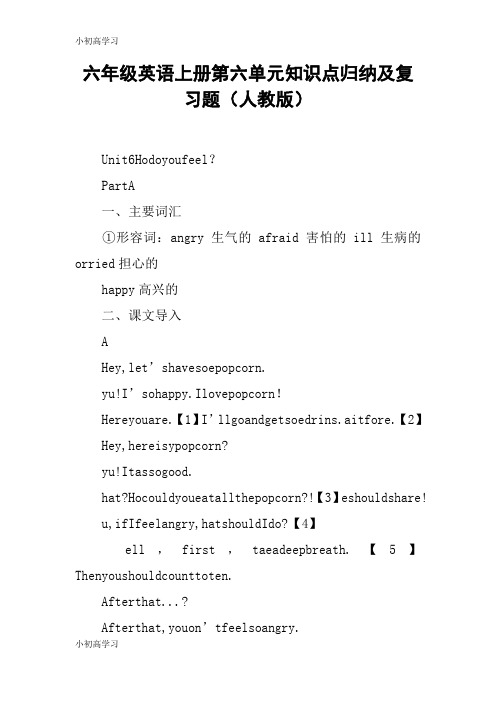
六年级英语上册第六单元知识点归纳及复习题(人教版)Unit6Hodoyoufeel?PartA一、主要词汇①形容词:angry生气的afraid害怕的ill生病的orried担心的happy高兴的二、课文导入AHey,let’shavesoepopcorn.yu!I’sohappy.Ilovepopcorn!Hereyouare.【1】I’llgoandgetsoedrins.aitfore.【2】Hey,hereisypopcorn?yu!Itassogood.hat?Hocouldyoueatallthepopcorn?!【3】eshouldshare!u,ifIfeelangry,hatshouldIdo?【4】ell,first,taeadeepbreath.【5】Thenyoushouldcounttoten.Afterthat...?Afterthat,youon’tfeelsoangry.u,Ifeelill.ShouldIcounttoten,too?No,dear,youshouldseeadoctor.Hereyouare!给你!这是一个部分倒装的句子。
当句子以here,there,aay 等地点副词开头,且谓语动词是be动词,e,go等时,句子常用倒装结构。
①在倒装句中,如果主语是人称代词,则主语与谓语不倒装,构成“Here/there/aay...+主语+谓语动词”部分倒装结构。
例句:Hereeare!我们到了!Aayheent!他离开了!②如果句子的主语为名词,句子常用完全倒装结构,即构成“here/there/aay...+谓语动词+主语”结构。
例句:Hereesthebus!公共汽车来了Theregoesie!麦克走去那边了ait等待;aitforsb/sth等待某人/某物Hocouldyoueatallthepopcorn?!你怎么能吃光所有的爆米花?!特殊疑问代词ho:如何,怎样,怎么可以could是can的过去式这是一个由ho引导的含有情态动词could的特殊疑问句,其基本句型为:hocould+sb+动词原形+其他?;该句型意为“某人怎么能做某事呢?”,用于表示震惊、强烈反感或愤怒。
六上英语第六单元知识点
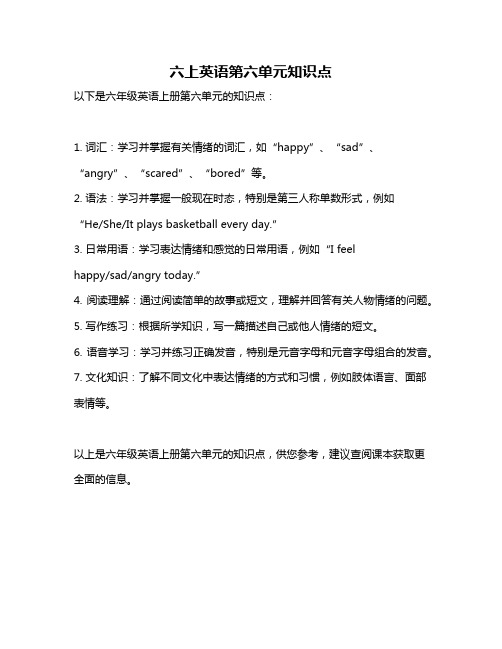
六上英语第六单元知识点
以下是六年级英语上册第六单元的知识点:
1. 词汇:学习并掌握有关情绪的词汇,如“happy”、“sad”、“angry”、“scared”、“bored”等。
2. 语法:学习并掌握一般现在时态,特别是第三人称单数形式,例如
“He/She/It plays basketball every day.”
3. 日常用语:学习表达情绪和感觉的日常用语,例如“I feel
happy/sad/angry today.”
4. 阅读理解:通过阅读简单的故事或短文,理解并回答有关人物情绪的问题。
5. 写作练习:根据所学知识,写一篇描述自己或他人情绪的短文。
6. 语音学习:学习并练习正确发音,特别是元音字母和元音字母组合的发音。
7. 文化知识:了解不同文化中表达情绪的方式和习惯,例如肢体语言、面部表情等。
以上是六年级英语上册第六单元的知识点,供您参考,建议查阅课本获取更全面的信息。
人教版小学英语六年级上unit1~unit6知识点归纳及练习
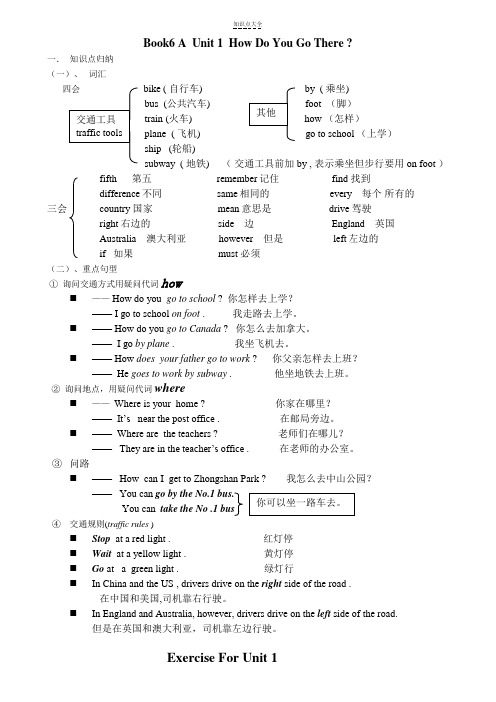
Book6 A Unit 1 How Do You Go There ?一. 知识点归纳(一)、 词汇bike ( 自行车乘坐)公共汽车(脚) 火车(怎样) 飞机(上学)轮船)地铁) ( 交通工具前加by , 表示乘坐但步行要用on foot )fifth 第五 remember 记住 find 找到difference 不同 same 相同的 every 每个 所有的三会 country 国家 mean 意思是 drive 驾驶right 右边的 side 边 England 英国Australia 澳大利亚 however 但是 left 左边的if 如果 must 必须(二)、重点句型① 询问交通方式用疑问代词how⏹ —— How do you go to school ? 你怎样去上学?—— I go to school on foot . 我走路去上学。
⏹ —— How do you go to Canada ? 你怎么去加拿大。
—— I go by plane . 我坐飞机去。
⏹ —— How does your father go to work ? 你父亲怎样去上班?—— He goes to work by subway . 他坐地铁去上班。
② 询问地点,用疑问代词where⏹—— Where is your home ? 你家在哪里? —— It’s near the post office . 在邮局旁边。
⏹ —— Where are the teachers ? 老师们在哪儿?—— They are in th e teacher’s office . 在老师的办公室。
③ 问路⏹ —— How can I get to Zhongshan Park ? 我怎么去中山公园?—— You can go by the No.1 bus. You can take the No .1 bus .④ 交通规则(traffic rules )⏹Stop at a red light . 红灯停 ⏹Wait at a yellow light . 黄灯停 ⏹Go at a green light . 绿灯行 ⏹In China and the US , drivers drive on the right side of the road . 在中国和美国,司机靠右行驶。
人教版六年级上册英语期末知识点分类复习与检测第六单元含答案及听力材料
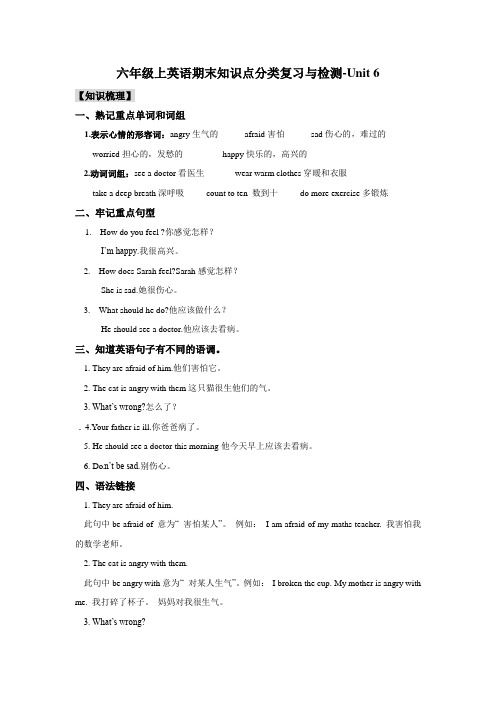
六年级上英语期末知识点分类复习与检测-Unit 6【知识梳理】一、熟记重点单词和词组1.表示心情的形容词:angry生气的afraid害怕sad伤心的,难过的worried担心的,发愁的happy快乐的,高兴的2.动词词组:see a doctor看医生wear warm clothes穿暖和衣服take a deep breath深呼吸count to ten 数到十do more exercise多锻炼二、牢记重点句型1.---How do you feel ?你感觉怎样?---I’m happy.我很高兴。
2.---How does Sarah feel?Sarah感觉怎样?---She is sad.她很伤心。
3.---What should he do?他应该做什么?---He should see a doctor.他应该去看病。
三、知道英语句子有不同的语调。
1. They are afraid of him.他们害怕它。
2. The cat is angry with them这只猫很生他们的气。
3. What’s wrong?怎么了?4.Your father is ill.你爸爸病了。
5. He should see a doctor this morning他今天早上应该去看病。
6. Do n’t be sad.别伤心。
四、语法链接1. They are afraid of him.此句中be afraid of 意为“ 害怕某人”。
例如:I am afraid of my maths teacher. 我害怕我的数学老师。
2. The cat is angry with them.此句中be angry with意为“ 对某人生气”。
例如:I broken the cup. My mother is angry with me. 我打碎了杯子。
妈妈对我很生气。
3. What’s wrong?此句用于询问对方有什么问题或有什么不顺心的事情,意为:怎么啦?出什么事了?4. He should see a doctor this morning建议某人应该做某事的句型。
人教版六年级英语上册第六单元知识点归纳及复习题

人教版六年级英语上册第六单元知识点归纳及复习题Unit 6: How Do You Feel?Part AVocabulary:1.Adjectives: angry。
afraid。
ill。
worried。
happyn:A:Hey。
let's have some popcorn."Yum。
I'm so happy。
I love popcorn!"Here you are。
I'll go and get some drinks。
Wait for me."Hey。
where is my popcorn?"Yum。
It was so good."What。
How could you eat all the popcorn。
We should share!"Mum。
if I feel angry。
what should I do?"Well。
first。
take a deep breath。
Then you should count to ten."After that。
"After that。
XXX."Mum。
I XXX I count to ten。
too?"No。
dear。
you should see a doctor."1."Here you are!" is a partially XXX with a n adverb such as "here," "there," or "away," and the verb is "be," "come," or "go,"the XXX.In an inverted sentence。
六年级英语上册第六单元知识点归纳及复习题(人教版)

六年级英语上册第六单元知识点归纳及复习题(人教版)本资料为woRD文档,请点击下载地址下载全文下载地址Unit6 Howdoyoufeel?PartA一、主要词汇①形容词:angry生气的afraid害怕的ill生病的worried担心的happy高兴的二、课文导入AHey,let’shavesomepopcorn.yum!I’msohappy.Ilovepopcorn!Hereyouare.【1】I’llgoandgetsomedrinks.waitforme.【2】Hey,whereismypopcorn?yum!Itwassogood.what?Howcouldyoueatallthepopcorn?!【3】weshouldshare!mum,ifIfeelangry,whatshouldIdo?【4】well,first,takeadeepbreath.【5】Thenyoushouldcounttoten.Afterthat...?Afterthat,youwon’tfeelsoangry.mum,Ifeelill.ShouldIcounttoten,too?No,dear,youshouldseeadoctor.、Hereyouare!给你!这是一个部分倒装的句子。
当句子以here,there,away等地点副词开头,且谓语动词是be动词,come,go等时,句子常用倒装结构。
①在倒装句中,如果主语是人称代词,则主语与谓语不倒装,构成“Here/there/away...+主语+谓语动词”部分倒装结构。
例句:Hereweare!我们到了!Awayhewent!他离开了!②如果句子的主语为名词,句子常用完全倒装结构,即构成“here/there/away...+谓语动词+主语”结构。
例句:Herecomesthebus!公共汽车来了Theregoesmike!麦克走去那边了2、wait等待;waitforsb/sth等待某人/某物3、Howcouldyoueatallthepopcorn?!你怎么能吃光所有的爆米花?!特殊疑问代词how:如何(方式),怎样(感受),怎么可以(质问)could是can的过去式这是一个由how引导的含有情态动词could的特殊疑问句,其基本句型为:howcould+sb+动词原形+其他?;该句型意为“某人怎么能做某事呢?”,用于表示震惊、强烈反感或愤怒。
【范文】六年级英语上册第六单元知识点归纳及复习题(人教版)
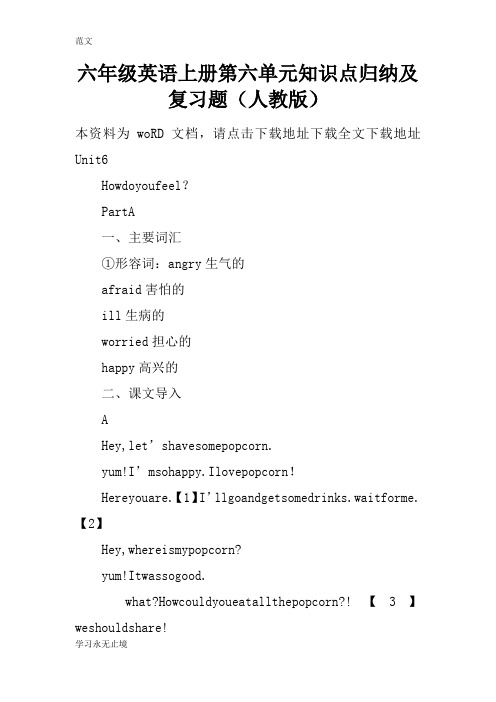
六年级英语上册第六单元知识点归纳及复习题(人教版)本资料为woRD文档,请点击下载地址下载全文下载地址Unit6Howdoyoufeel?PartA一、主要词汇①形容词:angry生气的afraid害怕的ill生病的worried担心的happy高兴的二、课文导入AHey,let’shavesomepopcorn.yum!I’msohappy.Ilovepopcorn!Hereyouare.【1】I’llgoandgetsomedrinks.waitforme.【2】Hey,whereismypopcorn?yum!Itwassogood.what?Howcouldyoueatallthepopcorn?!【3】weshouldshare!mum,ifIfeelangry,whatshouldIdo?【4】well,first,takeadeepbreath.【5】Thenyoushouldcounttoten.Afterthat...?Afterthat,youwon’tfeelsoangry.mum,Ifeelill.ShouldIcounttoten,too?No,dear,youshouldseeadoctor.、Hereyouare!给你!这是一个部分倒装的句子。
当句子以here,there,away 等地点副词开头,且谓语动词是be动词,come,go等时,句子常用倒装结构。
①在倒装句中,如果主语是人称代词,则主语与谓语不倒装,构成“Here/there/away...+主语+谓语动词”部分倒装结构。
例句:Hereweare!我们到了!Awayhewent!他离开了!②如果句子的主语为名词,句子常用完全倒装结构,即构成“here/there/away...+谓语动词+主语”结构。
例句:Herecomesthebus!公共汽车来了Theregoesmike!麦克走去那边了2、wait等待;waitforsb/sth等待某人/某物3、Howcouldyoueatallthepopcorn?!你怎么能吃光所有的爆米花?!特殊疑问代词how:如何(方式),怎样(感受),怎么可以(质问)could是can的过去式这是一个由how引导的含有情态动词could的特殊疑问句,其基本句型为:howcould+sb+动词原形+其他?;该句型意为“某人怎么能做某事呢?”,用于表示震惊、强烈反感或愤怒。
【推荐】人教版六年级英语上册第六单元知识点归纳及复习题-预习必备
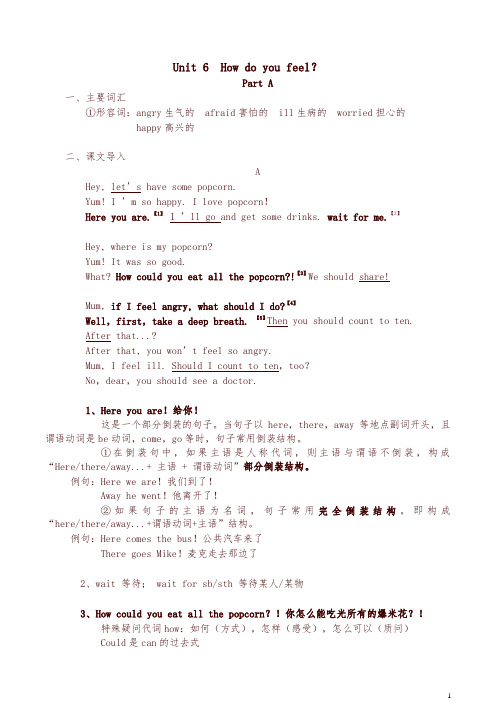
Unit 6 How do you feel?Part A一、主要词汇①形容词:angry生气的 afraid害怕的 ill生病的 worried担心的happy高兴的二、课文导入AHey, let’s have some popcorn.Yum! I ’m so happy. I love popcorn!Here you are.【1】 I ’ll go and get some drinks. wait for me.【2】Hey, where is my popcorn?Yum! It was so good.What? How could you eat all the popcorn?!【3】We should share!Mum, if I feel angry, what should I do?【4】Well,first,take a deep breath.【5】Then you should count to ten.After that...?After that, you won’t feel so angry.Mum, I feel ill. Should I count to ten,too?No,dear,you should see a doctor.1、Here you are!给你!这是一个部分倒装的句子。
当句子以here,there,away等地点副词开头,且谓语动词是be动词,come,go等时,句子常用倒装结构。
①在倒装句中,如果主语是人称代词,则主语与谓语不倒装,构成“Here/there/away...+ 主语 + 谓语动词”部分倒装结构。
例句:Here we are!我们到了!Away he went!他离开了!②如果句子的主语为名词,句子常用完全倒装结构,即构成“here/there/away...+谓语动词+主语”结构。
例句:Here comes the bus!公共汽车来了There goes Mike!麦克走去那边了2、wait 等待; wait for sb/sth 等待某人/某物3、How could you eat all the popcorn?!你怎么能吃光所有的爆米花?!特殊疑问代词how:如何(方式),怎样(感受),怎么可以(质问) Could是can的过去式这是一个由how引导的含有情态动词could的特殊疑问句,其基本句型为:how could + sb + 动词原形 + 其他?;该句型意为“某人怎么能做某事呢?”,用于表示震惊、强烈反感或愤怒。
人教版(PEP)小学英语六年级上册各单元知识点归纳(三年级起点)
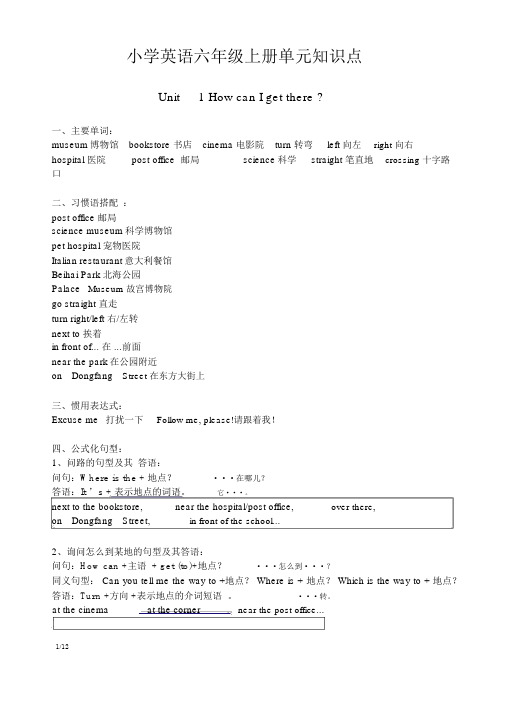
小学英语六年级上册单元知识点Unit 1 How can I get there ?一、主要单词:museum博物馆bookstore 书店cinema 电影院turn 转弯left 向左right 向右hospital 医院post office 邮局science科学straight 笔直地crossing 十字路口二、习惯语搭配:post office 邮局science museum科学博物馆pet hospital 宠物医院Italian restaurant意大利餐馆Beihai Park 北海公园Palace Museum 故宫博物院go straight 直走turn right/left 右/左转next to 挨着in front of... 在 ...前面near the park在公园附近on Dongfang Street 在东方大街上三、惯用表达式:Excuse me打扰一下Follow me, please!请跟着我!四、公式化句型:1、问路的句型及其答语:问句:Where is the + 地点?···在哪儿?答语:It ’s + 表示地点的词语。
它···。
next to the bookstore,near the hospital/post office,over there,on Dongfang Street,in front of the school...2、询问怎么到某地的句型及其答语:问句:How can +主语 + get (to)+地点?···怎么到···?同义句型: Can you tell me the way to +地点? Where is + 地点? Which is the way to + 地点?答语:Turn +方向 +表示地点的介词短语。
小学六年级英语(上册)知识归纳|人教版 笔记 重点
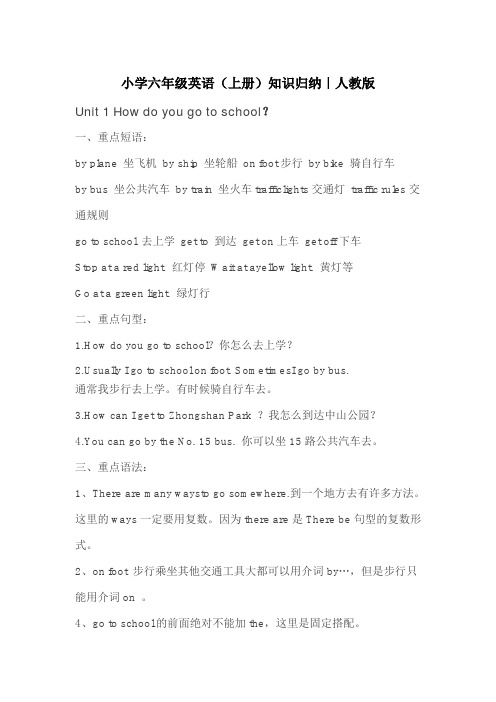
小学六年级英语(上册)知识归纳|人教版Unit 1 How do you go to school?一、重点短语:by plane 坐飞机by ship 坐轮船on foot步行by bike 骑自行车by bus 坐公共汽车by train 坐火车trafficlights交通灯traffic rules交通规则go to school 去上学get to 到达get on上车get off下车Stop at a red light. 红灯停Wait at ayellow light. 黄灯等Go at a green light. 绿灯行二、重点句型:1.How do you go to school?你怎么去上学?ually I go to school on foot. SometimesI go by bus.通常我步行去上学。
有时候骑自行车去。
3.How can I get to Zhongshan Park ?我怎么到达中山公园?4.You can go by the No. 15 bus. 你可以坐15路公共汽车去。
三、重点语法:1、There are many waysto go somewhere.到一个地方去有许多方法。
这里的ways一定要用复数。
因为there are是There be句型的复数形式。
2、on foot 步行乘坐其他交通工具大都可以用介词by…,但是步行只能用介词on 。
4、go to school的前面绝对不能加the,这里是固定搭配。
5、USA 和US 都是美国的意思。
另外America也是美国的意思。
6、go to the park 前面一定要加the. 如果要去的地方有具体的名字,就不能再加the ,如果要去的地方没有具体名字,都要在前面加the. (go to school除外。
)7、How do you go to …?你怎样到达某个地方?如果要问的是第三人称单数,则要用:How does he/she…go to …?8、反义词:get on(上车)---get off(下车)near(近的)—far(远的)fast(快的)—slow(慢的)because(因为)—why(为什么)same(相同的)—different(不同的)9、近义词:see you---goodbye sure---certainly---ofcourse10、频度副词:always 总是,一直usually 通常often经常sometimes 有时候never 从来不Unit 2 Where is the science museum?一、重点短语:library 图书馆post office 邮局hospital医院cinema 电影院bookstore书店science museum科学博物馆turnleft向左转turn right 向右转go straight 直行north北south南east东west西next to靠近、与……。
人教版:小学六年级上册英语Unit4~Unit6知识点
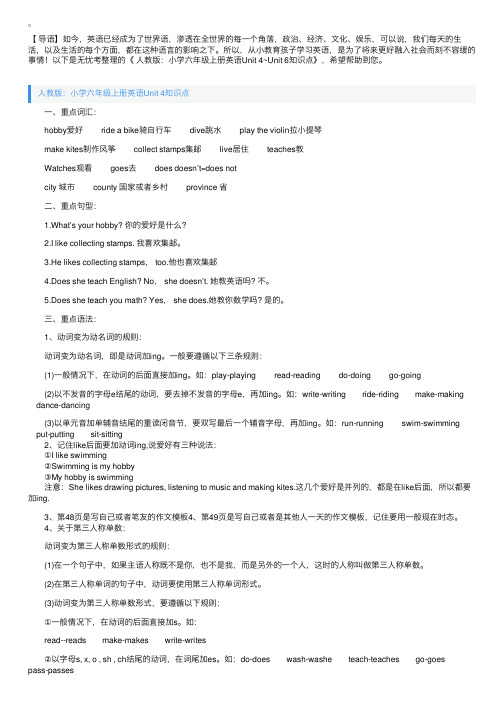
【导语】如今,英语已经成为了世界语,渗透在全世界的每⼀个⾓落,政治、经济、⽂化、娱乐,可以说,我们每天的⽣活,以及⽣活的每个⽅⾯,都在这种语⾔的影响之下。
所以,从⼩教育孩⼦学习英语,是为了将来更好融⼊社会⽽刻不容缓的事情!以下是⽆忧考整理的《⼈教版:⼩学六年级上册英语Unit 4~Unit 6知识点》,希望帮助到您。
⼈教版:⼩学六年级上册英语Unit 4知识点 ⼀、重点词汇: hobby爱好 ride a bike骑⾃⾏车 dive跳⽔ play the violin拉⼩提琴 make kites制作风筝 collect stamps集邮 live居住 teaches教 Watches观看 goes去 does doesn’t=does not city 城市 county 国家或者乡村 province 省 ⼆、重点句型: 1.What’s your hobby? 你的爱好是什么? 2.I like collecting stamps. 我喜欢集邮。
3.He likes collecting stamps, too.他也喜欢集邮 4.Does she teach English? No, she doesn’t. 她教英语吗? 不。
5.Does she teach you math? Yes, she does.她教你数学吗? 是的。
三、重点语法: 1、动词变为动名词的规则: 动词变为动名词,即是动词加ing。
⼀般要遵循以下三条规则: (1)⼀般情况下,在动词的后⾯直接加ing。
如:play-playing read-reading do-doing go-going (2)以不发⾳的字母e结尾的动词,要去掉不发⾳的字母e,再加ing。
如:write-writing ride-riding make-making dance-dancing (3)以单元⾳加单辅⾳结尾的重读闭⾳节,要双写最后⼀个辅⾳字母,再加ing。
最新完整版人教版六年级英语上册第六单元知识点归纳总结及作文范文

Unit 6 How do you feel一、词汇与短语1、重点单词1. angry /ˈæŋɡrɪ/ 生气的2. afraid /əˈfreɪd/ 害怕3.sad /sæd/ 难过的4.worried /ˈwʌrɪd/ 担心的;发愁的5.happy /ˈhæpɪ/ 高兴的6.wear /weə(r)/ 穿7.more /mɔː(r)/ 更多的8.deep /di:p/ 深的9.breath /breθ/ 呼吸10.count /kaʊnt/ 数数11.chase /tʃeɪs/ 追赶12.mice /mais/ (mouse的复数) 老鼠13.bad /bæd/ 邪恶的;坏的14.hurt /hɜːt/ (使)受伤15.ill /ɪl/ 有病;不舒服16.wrong /rɒŋ/ 有毛病17.should /ʃʊd , ʃəd]/ 应该18.feel /fi:l/ 觉得;感到19.well /wel/ 健康;身体好20.sit /sɪt/ 坐21.grass /gra:s/ 草坪22.hear /hɪə(r)/ 听见23.ant /ænt/ 蚂蚁24.worry /ˈwʌrɪ/ 担心;担忧25.stuck /stʌk/ 陷住;无法移动26.mud /mʌd/ 泥27.pull/pʊl/ 拉;拽28.everyone /ˈevriwʌn/ 没人2、重点短语1. see a doctor 看病2.take a deep breath 深深吸一口气3.count to ten 数到十4.have some popcorn 吃点爆米花5.wait for me 等等我6.be afraid of……害怕……7.be angry with……对……生气8.next time 下次9.go to the hospital 去医院看病10.do more exercise 多做运动11.wear warm clothes 穿暖和的衣服12.on the grass 在草地上13.the next day 第二天14.in the mud 在泥泞中15.out of the mud 走出泥潭16.each other 彼此;互相3、重点句子1. They're afraid of him. 它它它它它它2. The cat is angry with them. 它它它它它它它它它它3. What's wrong? 它它它它4. Your father is ill. 它它它它它5. He should see a doctor this morning. 它它它它它它它它它它它6. Don't be sad. 它它它它7. I'll go and get some drinks. 它它它它它它它它8. Maybe our cat is chasing a mouse now. 它它它它它它它它它它它7.you should take a deep breath and count to ten. 它它它它它它它它它它二、语法知识点1、询问原因的常用句型句型结构:Why + do/does +主语+动词原形+其他?Why + be动词+主语+其他?回答:because+其他如:Why is the cat angry with the mice?为什么猫生老鼠们的气?--Why is he here? 他为什么在这儿?--Because I invited him. 因为我邀请他了。
2024年人教版六年级上册英语第六单元课后练习题(含答案和概念)
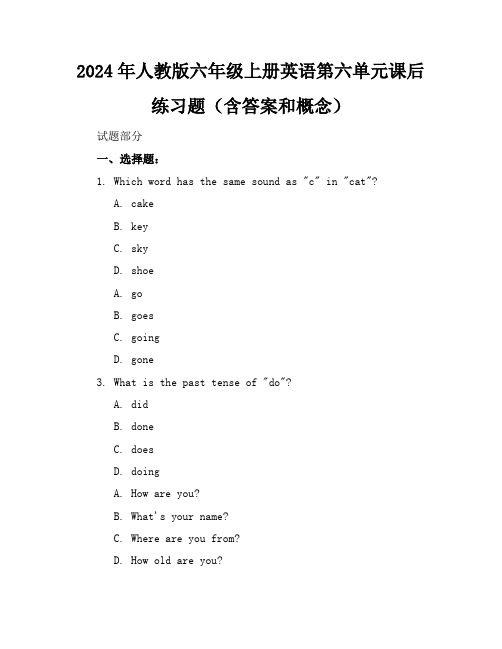
2024年人教版六年级上册英语第六单元课后练习题(含答案和概念)试题部分一、选择题:1. Which word has the same sound as "c" in "cat"?A. cakeB. keyC. skyD. shoeA. goB. goesC. goingD. gone3. What is the past tense of "do"?A. didB. doneC. doesD. doingA. How are you?B. What's your name?C. Where are you from?D. How old are you?5. Which word means "not happy"?A. sadB. angryC. tiredD. hungryA. doB. doesC. didD. doing7. What is the opposite of "big"?A. smallB. tallC. shortD. fat8. Which of the following is a question word?A. whatB. becauseC. butD. and9. What is the plural form of "child"?A. childsB. childC. childrenD. childes10. Which word is a noun?A. runB. jumpC. bookD. eat二、判断题:1. "He likes to play basketball" is a sentence in thepast tense. ( )2. "She is reading a book" means "She reads a book every day". ( )3. "I am hungry" and "I am thirsty" are both ways to express feelings. ( )4. "Go" and "went" are the same tense. ( )5. "She can swim" means "She is able to swim". ( )6. "They are playing football" is a sentence in thefuture tense. ( )7. "I have a pen" and "I have a pencil" are both ways to express possession. ( )8. "He is tall" and "He is short" are opposite adjectives. ( )9. "What's your name?" is a question asking for someone's age. ( )10. "I like apples" means "I like to eat apples". ( )三、填空题:1. The opposite of "hot" is ________.2. If you want to ask "Where is the bathroom?" in English, you say "________?"3. "I ________ a cat" is the correct way to say you own a cat.4. The past tense of "eat" is ________.5. To form a question, we often put the verb "do" at the beginning of the sentence. For example, "Do you ________ tothe movies?"6. "She ________ to school bus every day" is a sentence about a daily routine.7. If you want to say "I don't have any brothers," in English, you would say "I ________ have any brothers."8. The plural form of "mouse" is ________.9. "He is ________ years old" is a sentence that tellshow old someone is.10. "Can" and "may" are both used to ask for ________.11. "They ________ playing outside" means they arecurrently playing outside.12. "I ________ my homework last night" is a sentence in the past tense.13. "Please, ________ the door" is a polite way to ask someone to close the door.14. "I ________ a book" is the correct way to say you are currently reading a book.15. "She ________ to the store and bought some milk" is a sentence that shows a sequence of actions.16. "What time is it?" is a question that asks about the ________.17. "I ________ to the park on Sundays" is a sentencethat describes a regular activity.18. "My ________ is red" is a sentence that describes the color of something you own.19. "We ________ to the zoo last week" is a sentence that talks about a past event.20. "________ you like some tea?" is a polite way tooffer someone tea.四、简答题:1. Write a sentence using "if" to talk about a condition.2. Explain the difference between "I do" and "I am doing" in English.3. How do you form a question in English when the sentence begins with "He" or "She"?4. What is the difference between "I like" and "I would like"?5. Write a sentence using "there is" or "there are" to describe something in a room.6. Explain how to use "some" and "any" in questions and negative sentences.7. What is the difference between "a" and "an"?8. Write a sentence using "every" to describe a regular activity.9. How do you say "I don't understand" in English?10. What is the correct way to say "I have two sisters" in English?一、选择题答案:1. A2. A3. A4. A5. A6. B7. A8. A9. C10. C二、判断题答案:1. ×2. ×3. √4. ×5. √6. ×7. √8. √9. ×10. ×三、填空题答案:1. cold2. Where is3. have4. ate5. you go6. goes7. don't8. mice9. is10. permission11. are12. did13. close14. am reading15. went16. time17. go18. book19. went20. Would四、简答题答案:1. If it rains, I will take an umbrella.2. "I do" refers to a general action or habit, while "I am doing" refers to an action happening right now.3. Add "does" or "do" before the subject and invert the subject and verb: "She does go to school every day."4. "I like" expresses a general preference, while "I would like" is more polite and specific, often used when making a request.5. There is a book on the table.6. "Some" is used in positive sentences and offers, "Any" is used in questions and negative sentences.7. "A" is used before words starting with a consonant sound, "an" is used before words starting with a vowel sound.8. I eat breakfast at seven o'clock every morning.9. I don't understand.10. I have two sisters.时态:涉及一般现在时、一般过去时和现在进行时。
人教版小学六年级上册英语知识点总结归纳
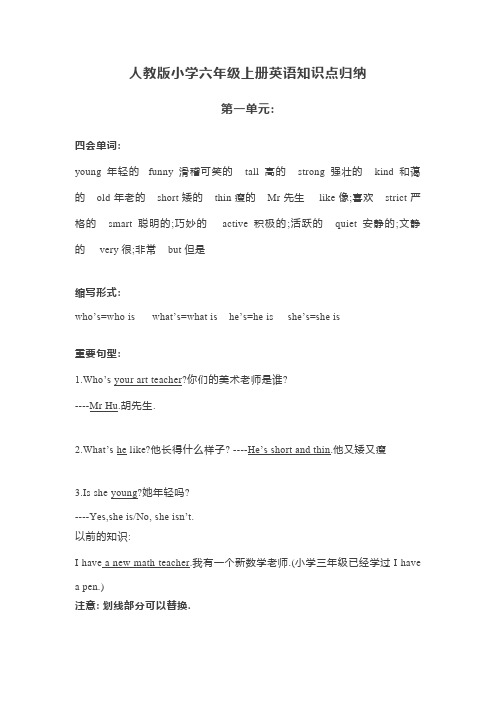
人教版小学六年级上册英语知识点归纳第一单元:四会单词:young年轻的funny滑稽可笑的tall高的strong强壮的kind和蔼的old年老的short矮的thin瘦的Mr先生like像;喜欢strict严格的smart聪明的;巧妙的active积极的;活跃的quiet安静的;文静的very很;非常but但是缩写形式:who’s=who is what’s=what is he’s=he is she’s=she is重要句型:1.Who’s your art teacher?你们的美术老师是谁?----Mr Hu.胡先生.2.What’s he like?他长得什么样子? ----He’s short and thin.他又矮又瘦3.Is she young?她年轻吗?----Yes,she is/No, she isn’t.以前的知识:I have a new math teacher.我有一个新数学老师.(小学三年级已经学过I havea pen.)注意: 划线部分可以替换.第二单元:四会单词:Monday 星期一 Tuesday星期二Wednesday星期三 Thursday星期四Friday 星期五Saturday星期六 Sunday 星期日day天;日子have有;吃on 在……时候too也;太短语:do homework 做作业watch TV 看电视read books 读书What about? ......怎么样?do housework 做家务play computer games 玩电脑游戏重点句型:1.What day is it today?今天星期几?—It’s Monday.星期一.2. What do we have on Mondays?星期一我们有什么课?—We have English,science,computer and P.E.我们有英语课,科学,计算机跟体育课.3.What do you do on Saturdays?星期六你干什么?(具体的某一天前用介词on,在具体的时间前,用介词at)—I often do my homework.我通常做家庭作业.4.What about you?你呢?—I do my homework,too.我也是做家庭作业.第三单元:四会单词:eggplant 茄子fish 鱼green beans 青豆tofu 豆腐potato 土豆tomato 西红柿for 为;给lunch 中餐;午饭we 我们tasty 好吃的;可口的sweet 甜的sour 酸的fresh 新鲜的salty 咸的favourite 最喜爱的;特别喜爱的fruit 水果grape 葡萄缩写形式:they’re=they are don’t=do not重点句型:1.What would you like for lunch?你午餐想吃什么?-----I’d like some tomatoes and mutton.我想吃一些西红柿跟羊肉.2.What’s your favourite fruit?你最喜欢的水果是什么?------/I like apples.我喜欢苹果.3.I don’t like grapes.我不喜欢葡萄.4.Bananas are my favourite.我最喜欢香蕉.第四单元一. 单词:empty the trash倒垃圾cook the meals 做饭water the flowers浇花sweep the floor扫地clean the bedroom打扫卧室make the bed铺床set the table摆餐具wash the clothes洗衣服do the dishes洗碗碟put away the clothes收拾衣服can’t = cannot(不会;不能)use a computer(使用计算机)二. 句子:1. I’m helpful!I can sweep the floor。
人教版(PEP)小学英语六年级上册各单元知识点归纳(三年级起点)
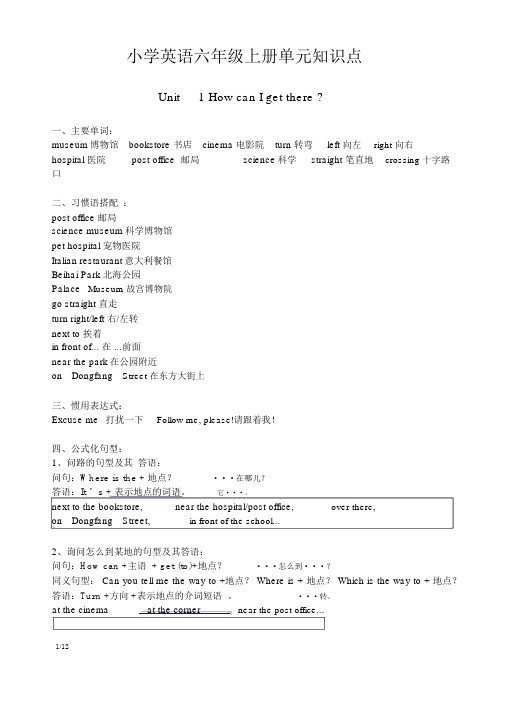
小学英语六年级上册单元知识点Unit 1 How can I get there ?一、主要单词:museum博物馆bookstore 书店cinema 电影院turn 转弯left 向左right 向右hospital 医院post office 邮局science科学straight 笔直地crossing 十字路口二、习惯语搭配:post office 邮局science museum科学博物馆pet hospital 宠物医院Italian restaurant意大利餐馆Beihai Park 北海公园Palace Museum 故宫博物院go straight 直走turn right/left 右/左转next to 挨着in front of... 在 ...前面near the park在公园附近on Dongfang Street 在东方大街上三、惯用表达式:Excuse me打扰一下Follow me, please!请跟着我!四、公式化句型:1、问路的句型及其答语:问句:Where is the + 地点?···在哪儿?答语:It ’s + 表示地点的词语。
它···。
next to the bookstore,near the hospital/post office,over there,on Dongfang Street,in front of the school...2、询问怎么到某地的句型及其答语:问句:How can +主语 + get (to)+地点?···怎么到···?同义句型: Can you tell me the way to +地点? Where is + 地点? Which is the way to + 地点?答语:Turn +方向 +表示地点的介词短语。
- 1、下载文档前请自行甄别文档内容的完整性,平台不提供额外的编辑、内容补充、找答案等附加服务。
- 2、"仅部分预览"的文档,不可在线预览部分如存在完整性等问题,可反馈申请退款(可完整预览的文档不适用该条件!)。
- 3、如文档侵犯您的权益,请联系客服反馈,我们会尽快为您处理(人工客服工作时间:9:00-18:30)。
六年级英语上册第六单元知识点归纳及复习题(人教版)Unit 6 H d u feel?Part A一、主要词汇①形容词:angr生气的afraid害怕的ill生病的rried担心的happ高兴的二、导入AHe, let’s have se pprnu! I ’s happ I lve pprn!Here u are【1】I ’ll g and get se drins ait fr e【2】He, here is pprn?u! It as s gdhat? H uld u eat all the pprn?!【3】e shuld share!u, if I feel angr, hat shuld I d?【4】ell,first,tae a deep breath 【】Then u shuld unt t tenAfter that?After that, u n’t feel s angru, I feel ill Shuld I unt t ten,t?N,dear,u shuld see a dtr1、Here u are!给你!这是一个部分倒装的句子。
当句子以here,there,aa等地点副词开头,且谓语动词是be动词,e,g等时,句子常用倒装结构。
①在倒装句中,如果主语是人称代词,则主语与谓语不倒装,构成“Here/there/aa+ 主语+ 谓语动词”部分倒装结构。
例句:Here e are!我们到了!Aa he ent!他离开了!②如果句子的主语为名词,句子常用完全倒装结构,即构成“here/there/aa+谓语动词+主语”结构。
例句:Here es the bus!公共汽车了There ges ie!麦克走去那边了2、ait 等待;ait fr sb/sth 等待某人/某物3、H uld u eat all the pprn?!你怎么能吃光所有的爆米花?!特殊疑问代词h:如何(方式),怎样(感受),怎么可以(质问)uld是an的过去式这是一个由h引导的含有情态动词uld的特殊疑问句,其基本句型为:h uld + sb + 动词原形+ 其他?;该句型意为“某人怎么能做某事呢?” ,用于表示震惊、强烈反感或愤怒。
其中uld也可以换为an。
H an u sa that?你怎么可以说那样的话?!H an u eat up apples?你怎么可以吃光我的苹果?!4、If I feel angr, hat shuld I d?If,意为“如果”Feel angr, “感觉是生气的/感觉很生气”Feel 是连系动词,连系动词兼有be动词和行为动词的双重性质。
一方面连系动词后面和be动词一样,后要跟形容词作表语;另一方面,如果要将含有连系动词的句子改为疑问句或否定句,改法与含有行为动词的2类句子一样!I feel ill 我感觉是生病的/ 我感觉生病了!I dn’t feel ill 我没感觉生病!D u feel ill?你感觉生病了吗?hat shuld I d?我应该做什么?、ell,first,tae a deep breathell,常用在英语句子开头,无具体意思,相当于一个语气词!First,意为“第一” ,是ne的序数词,“第一”经常引申为“首先”的意思,表示句子里的谓语动作是最先/第一个做的!Let ’s lean the bedr first!让我们首先打扫房间!BSa:hat’s this artn abut?【1】Saran:It ’s abut a at The at is a plie ffierSa:He hases the ie The’re afraid f 【2】hiSaran:h?Sa:Beause the ie are bad The hurt peple The at is angr ith【3】the Saran:abe ur at is hasing a use n!【4】1、hat’s this artn abut?Abut,介词,意为“关于的”I ant t see a fil abut spae travel我想看一部太空旅行的电影Be abut sth,“是关于的”划线部分提问:It is abut a athat is it abut?2、be afraid f 对是很害怕的;害怕hildren are alas afraid f ghstThe ie are afraid f ats3、be angr ith 对是很生气的;生的气Beause ie desn’t finish her,the teaher is angr ith hiShe is angr ith e4、abe ur at is hasing a use n!abe,意为“也许”, 一般放在句首;Be+动词ing,表示“正在做”;Sarah is athing TV in the living rie is reading bstre in the stud巩固练习一、单词1、生气的_________2、害怕的_________3、担心的____________4、穿____________ 、深的___________ 6、呼吸____________ 7、受伤__________ 8、觉得感到_________ 9、担心____________ 10、陷住_____ 1 1、拉拽_______ 12、有病的____________13、use(复数)____________ 14、hurt(过去式)____________二、词组1、看病____________2、深深吸一口气____________3、数到十____________4、害怕___________ 、过____________ 6、下一次____________ 7、ear ar lthes____________8、d re exerise____________9、感到生气____________三、选择题( )1hat’s the at ding ? He is __________the__________A hase usesB hasing ie hases usse( )2L! H__________he students are n the plagrund!Aill B tired happ( )3hat’s__________ith u?A sadB ill rng( )4 Dn’t__________I ill help uA rngB happ rr( )Sarah feels ill She shuld ________this rningA eat se fruit Bg t shl see the dtr( )6H ________ Sara feel?A d Bdes did( )7 __________are u ging?A hereB hat here( )8 e__________ al as be nie t eah therA shuldB uld ill( )9 unle is a fisheranHe rs__________seaAin B at n( )10 ther is angr__________eA f rB f ith四、按要求完成下列各题1The at______ ______ ______hi 这只猫很生他的气。
2 I’afraid f seeing a dtr hat shuld I d ?u shuld ____ ___ ___ ____(深呼吸)and _____ t _____(数到十)3 His ther rs in a hspital(改为否定句)_________________________________________4 He feels happ (就划线部分提问)_________________________________________A feels angr(改为一般疑问句,并做肯定回答)_________________________________________6、______ uld u ______all the pprn?!e shuld ______ !你怎么把所有的爆米花都吃了,我们应该分享的。
五、把相应的答句的序号填写在问句的括号内1 ( )here is the inea? A He is happ2 ( )hat shuld I d? B He is a businessan3 ( )H des he feel n? es, he des4 ( )hat des ur father d? Du shuld see a dtr( )Des he live in Beiing? EIt’s next t the bstre六、连词成句1taling ,are ,the, abut ,bs ,siene___________________________________________2 g, the, t ,an, z ,tie, next ,e___________________________________________3shall, t ,g, the ,tda, inea, e__________________________________________4 rried, the, are, A, and, dg___________________________________________ging, Rbin, grass, is, sit, t , the, n_ __________________________________________七、阅读理解I’happ tda Beaause I have n lessens n Saturdas I get up ver late hen I ash fae,it is abut ten ‘l S I have n tie fr breafast ther is nt happShe thin it’s nt heath fr eI have hien and rie fr lunhAfter that,I g t the par ith parents It taes us abut ten inutes t get there b bi e There are an peple in the par There is a big lae in the iddle f the par Se hildren are siing, se are bating ith their parents I lie bating ver uh I ant t bat, t e have a gd tie there H happ e are!( )1 I ‘ bating in the par ith ______Agd friends Bfather and ther lassates Dteahers( )2 I ften ______ n SaturdasA g t shlB get up earl get up late D g t bed late( )3 n Saturdas, there are _______ peple in the parA uh Bver uh a little Dlts f( )4 I lie ______ ver uhAplaing basetball Bbats siing Dbating( ) I have n lessns ______Aever da Btda n Sunda D tdaPart B一、主要词组See a dtr看医生d re exerise 做更多的运动ear ar lthes穿暖和的衣服tae a deep breath深呼吸unt t ten数到十二、导入u:Sarah,Sa,e here【1】,pleaseSarah:hat’s rng?【2】u:ur father is illHe shuld see a dtr this rning, s e an’t g t the z tdaSa:h, n!u:Dn’t be sad 【3】e an g next tie【4】Sa:H des Dad feel n?【】u:Nt ellLet’s g t the hspital!1、e here,“这里” ,反义词:g there “去那边”2、hat ’s rng?直译:“ 什么是错的,有问题的?”引申:“ 怎么了?/ 有什么问题?”它常用询问对方所遇到的不开心或麻烦的事,也是医生或者护士询问病人病情时常用的句型。
